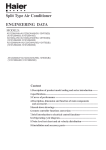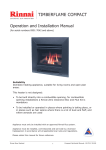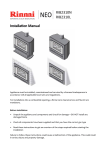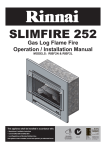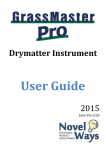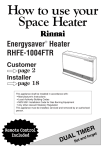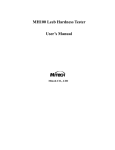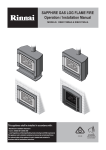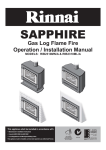Download Rinnai Amplify Installation manual
Transcript
RINNAI Reflection Flame Fire Operation and Installation Manual This appliance shall be installed in accordance with: •Manufacturer’s Installation Instructions •Local Gas Fitting Regulations •NZS 5261 and Australian Installation Code AS5601 • Municipal Building Codes •Any other local relevant statutory regulation This product is only to be installed with an approved Rinnai flue system. Installation and service must be performed by an authorised person. INSTALLER: Please leave this manual with the customer after installation OWNER: Please retain this manual for future reference Rinnai New Zealand Reflection: 03-08 Limited Warranty Rinnai Reflection Flame Fires Rinnai brings you peace of mind with a 2 year minimum warranty. TERMS AND CONDITIONS 3. Warranty claims may be invalid if not accompanied by details of the installing or 1. During the 24 month period from date of supervising gas fitter’s registration number and purchase and subject to clauses 2 and 3 below, the gas fitting certification number. Rinnai New Zealand Limited (“Rinnai”) will, at its own discretion, either replace or repair any 4. This warranty commences from the date of defective product at no charge to the customer. purchase. Proof of purchase is required at the time of any warranty claim. 2. This warranty covers manufacturing defects only. This warranty will not apply if (for 5. Servicing of the product is to be carried out by a example) the product has been improperly Rinnai authorised service centre. installed or is otherwise installed contrary to All Rinnai appliances meet or exceed the safety manufacturer’s recommendations, has been standards required by New Zealand gas and damaged during or after installation, has not electrical regulations. The company is constantly been operated in accordance with operating improving its products and as such specifications instructions, or has been subjected to damage are subject to change or variation without notice. or abuse beyond that expected from conditions of normal use. Please keep these instructions in a safe place for future reference. RECORD AND ATTACH YOUR PROOF OF PURCHASE BELOW: Your Retailer:____________________________________________________ Name:_________________________________________________________ Address:_______________________________________________________ _______________________________________________________________ Telephone:( _______ ) ____________________________________________ Date of Purchase: ______ / ______ / _________ Rinnai New Zealand Reflection: 03-08 Table of Contents Limited Warranty............................................................................................. Customer Information - Introduction.................................................................. Customer Information - Design Layout............................................................... Customer Information - Safety.......................................................................... Customer Information - Installation................................................................... Customer Information - ETR Operation............................................................... Customer Information - Maintenance, Servicing and Repair................................... Customer Information - Troubleshooting............................................................. Customer Information - Error Codes ................................................................. 2 4 5 6 7 9 13 14 14 Installer Information - Dimension Diagrams........................................................ Installer Information - Appliance Location........................................................... Installer Information - Gas Supply and Connection............................................... Installer Information - Flueing - General Guidelines.............................................. Installer Information - Flueing - Existing Fireplace............................................... Installer Information - Flueing - Decorative Fireplace............................................ Installer Information - Installation Procedure...................................................... Installer Information - Testing Procedure............................................................ Installer Information - Installing the Frame, Trims and Dress Guard....................... Installer Information - Installing the In-Wall Control Panel.................................... Installer Information - Commissioning Checklist.................................................. Installer Information - Wiring Diagram............................................................... Customer Contacts.......................................................................................... 16 17 18 19 20 21 23 27 28 29 30 31 36 WARNING Improper installation, adjustment, alteration, service or maintenance can cause property damage, personal injury or loss of life. For assistance or additional information consult an authorised person or Rinnai on 0800 RINNAI (0800 746 624). Installation and service must be performed by an authorised person. Rinnai New Zealand Reflection: 03-08 Introduction Congratulations on the purchase of your Rinnai Reflection Flame Fire. Rinnai has been supporting New Zealand for over 30 years with quality appliances, and we’re proud to have our products used everyday by many New Zealanders. Rinnai Reflection...a reflection of inspired design, from an initial pencil sketch to ingeniously designed, precision-engineered working models. The result is a New Zealand-made fire that combines unrivalled energy efficiency with world-leading aesthetics and ergonomic considerations. Available in three designer models: • Advance (best suited to masonry installations) • Amplify (best suited to floor mounted false chimney installations) • Elevate (best suited to up-wall false chimney installations) Advance Rinnai New Zealand Amplify Elevate Reflection: 03-08 General Design Layout The Reflection models differ only in the colour of frame surround and installation application. Reflection Advance Extruded aluminium frame available in two colour options; Galaxy Black and Dark Bronze (interchangeable) Black Trim Kit, stainless steel option can be purchased as an additional accessory to customise the look of the fire Black Grill Plate - warm air discharge Reflection Engine Log Set Flat Glass Front Extruded aluminium spacer available in two colour options; Galaxy Black and Dark Bronze Receiver Window, remote control receiver. Black Grill Plate - air inlet Reflection Amplify and Elevate Extruded aluminium frame available in three colour options; Galaxy Black, Dark Bronze and Champagne Silver (interchangeable) Rinnai New Zealand Reflection: 03-08 Safety Do not restrict the warm air discharge by placing articles in front of the appliance. This appliance must not be used for any purpose other than heating. Do not spray aerosols whilst the appliance is operating. Most aerosols contain butane gas, which can be a fire hazard if used near the appliance when it is in use. Young children should be supervised at all times. Hand or body contact with the heater must be avoided. Do not sleep directly in front of the appliance. Do not allow anyone to sit on or lean against the appliance. Do not allow anyone to post articles through into the heater. Do not allow curtains or other flammable or combustible materials to come into contact with appliance. Do not unplug the appliance while it is in operation. Unplugging the appliance will switch it off and will reset the appliance to its default settings. Some floorings will react to heat. Therefore it is recommended that a mat be placed in front of the appliance when it is in operation. When the appliance is operated for the first time or after long periods of non-use a slight odour may be emitted. This is normal, however if odours persist switch off the appliance and contact a Rinnai Service Centre. A dedicated 230~240V 10 Amp power point must be used with this appliance. Do not use power boards or double adaptors to operate this appliance. Do not place articles on or against this appliance. Do not use or store flammable materials near this appliance. Do not spray aerosols in the vicinity of this appliance whilst in operation. Rinnai New Zealand Reflection: 03-08 Installation Unpacking the Appliance and Associated Accessories Unpack the appliance and check for damage. If damaged contact your supplier for advice. Do not install a damaged appliance. Before installing, check the label for correct gas type and that you have all the components you need, refer checklist on page 23). Gas type label is displayed on the appliance Before using this appliance, please read this manual to ensure correct use. Failure to follow these instructions could cause a malfunction of the appliance. This could result in death, serious bodily injury and/or property damage. Failure to follow these instructions may also void your fire insurance and/or warranty. Compliance with Local Regulations The appliance must be installed in accordance with local gas and electrical authority regulations. Power Cord Appliance must not be located below a power socket outlet. Local gas and electrical authorities will be able to advise on local regulations. If the supply cord is damaged or requires replacing, it must be replaced by an authorised person. This must be a genuine replacement part available from Rinnai. Gas Consumption 30-11MJ/h (high to low) Ventilation Ensure that the area in which the appliance is installed has adequate ventilation. This ventilation must be provided as per NZS 5261:2003 2.6.6. Gas Cylinder Do not connect to an LPG/Propane gas cylinder indoors. Floor Protection Heat emanating from the front of this fire may over time affect the appearance of some materials used for flooring such as carpet, vinyl, cork or timber. This may be amplified if the air in the room contains cooking vapours or cigarette smoke. To avoid this occurring, it is recommended that a mat be placed in front of the appliance. Supervision Required The appliance is not intended for use by young children or infirm persons without supervision. Young children should be supervised to ensure they do not play with the appliance. Painting and Dusty Environments Do not operate/install this appliance in places where painting is taking place, or in places such as hair dressing salons, where there may be a lot of dust and ‘fluff’, and where aerosols are used. Flueing A gas appliance must not be connected to a chimney flue serving as a separate solid-fuel burning appliance. For installations into new (decorative) fireplaces a Rinnai Zero Clearance Box and Zero Clearance Flue Kit is required. Failure to meet this criteria will void any product warranty. For existing masonry installations, to ensure adequate draw of the appliance, Rinnai strongly recommends the use of a Rinnai Flexiliner Flue system. Failure to meet this criteria may result in an unsafe situation. Installation without a flexiliner flue is permissible as long as the chimney is checked for soundness and ability to achieve a good draw. Rinnai New Zealand Reflection: 03-08 Installation Clearances The appliance must not be installed where curtains or other combustible materials could come into contact with it. In some cases, curtains may need restraining. 300mm 300mm 300mm 10 00 mm Mantles, Surrounds and Hearths Mantles and surrounds can be added to compliment design providing they conform to the clearances below. maxim um d epth = 15 0mm (at 2 00mm ) 200 mm 30 0m m 300 mm Mantles Hearths • Minimum clearance of 200mm above the fire and a maximum of 150mm at this height • For additional overhang, 100mm of vertical clearance is required for every 50mm of added depth, i.e. a 200mm mantle requires 300mm of vertical clearance A hearth is not necessary but can be used for decorative purposes or protection of sensitive flooring materials if required. If used the bottom of the appliance must be level with the top of the hearth so there is a continuous level. Rinnai New Zealand Reflection: 03-08 ETR Operation Control Panel Layout Lock Indicates lock function Flame High heat setting, fan on low speed, also overrides thermostat AM/PM Time/Temperature Display Shows either the time of day, room and set temperatures or coded error messages Clock Adjustment and Timer Indicators Indicates that clock or dual timer programme is being set Override Temporarily changes operation from ON to OFF or OFF to ON, until next programmed setting is reached Timer 1 and Timer 2 Indicates that Timer 1 or Timer 2 has been selected to operate Temperature / Time Adjustment Increases or decreases the temperature setting as well as changing hours or minutes AUTO OFF When ON, thermostat turns heat down to OFF. When OFF, thermostat turns heat down to low (prevents overheating in small rooms) ON/OFF Main switch for turning ON / OFF Turning On Press the ON / OFF button to operate the heater. The ON indicator will glow green. The spark generator will be heard before the burner ignites and the ON indicator glows red, indicating that the burner is alight. The fan will come on automatically after four minutes after which warm air can be felt coming from the top grill. Note: If the heater does not ignite on initial use, this may be due to air remaining in the gas supply line. The spark generator will only continue for 15 seconds. After this it will be necessary to press the ON / OFF button OFF, then ON again. Turning Off Press the ON / OFF button to switch off the heater. The ON indicator will go out. The fan will continue to operate for several minutes after the burner has gone out in order to cool the appliance. Do not unplug the appliance while the fan is running. Room Temperature Adjustment The room temperature and pre-set temperatures can only be displayed and adjusted when the heater is running. Press the button to increase the temperature setting or temperature setting. Rinnai New Zealand button to decrease the Reflection: 03-08 ETR Operation Lock The ‘Lock’ function will help prevent accidental operation and small children from altering the controls. To operate press the ‘Lock’ button. The function is activated immediately and the ‘Lock’ indicator will glow. To deactivate press the ‘Lock’ button for three seconds and the ‘Lock’ indicator will go out. During normal operation the ‘Lock’ may be activated and all the controls, other than the OFF switch, will be locked. Deactivating the ‘Lock’ releases the controls. If the ‘Lock’ is activated whilst the heater is turned off, then all functions will be locked. If the heater is turned off while the ‘Lock’ is activated, it cannot be turned on again until the ‘Lock’ is deactivated. Flame To operate press the ‘Flame’ button. This function will automatically override the thermostat and set the heater to a default high heat setting for full visual flame effect. Auto Off The ‘AUTO OFF’ function is an energy saving feature designed to control the room temperature economically. If the room temperature continues to rise when the heater is thermostatically turned down to its lowest setting the front burner will turn off leaving only the pilot flame operating. When the room temperature requires further heating the heater will automatically re-ignite to warm the room. This feature also prevents overheating in small rooms. Override This function is intended to be used to manually override the current operation of the heater when the heater is in ‘Timer’ mode. For example: if the heater is in standby mode (i.e. between the finishing and starting timer of a timer operation), and the ‘Override’ button is selected, then the heater will begin to operate and heat the room. To operate press the ‘Override’ button, the ‘Override’ indicator will flash. To manually deactivate press the ‘Override’ button again. The ‘Override’ indicator will go out, and the heater will return to standby mode. The heater will continue to operate in ‘Override’ until the ‘Override’ button is pressed again, or one of the timers takes over the operation of the appliance. This means that the ‘Override’ mode will automatically drop out if a programmed starting time is reached. The appliance will then return to operating at times programmed into the ‘Timer(s)’. Remote Control The remote control will not turn heaters on if ‘Timer(s)’ have been set. To manually operate when ‘Timer(s)’ are not selected, press the ‘ON’ or ‘OFF’ button. To alter the temperature when the heater is operating, press the or buttons. Rinnai New Zealand 10 Reflection: 03-08 ETR Operation Remote Control continued Important points: • Some fluorescent lights may interfere with the transmission of remote control signals, changing the position from which you are operating the remote may help • Avoid dropping the remote or getting it wet • Remote control works within five metres of the receiver from the heater • Remove battery if control is not going to be used for a long period, this will help avoid damage from leaking batteries. If the ‘Timer(s)’ have been selected, and the heater is in standby mode, and the ‘OFF’ button on the remote control is pressed, the ‘Timer(s)’ will be deactivated. Batteries are supplied with the remote when ordered with the fire. If purchasing the remote as an additional accessory batteries are not included. Setting the Clock Example, setting the clock to 10:35am 1. Press the ‘Set Times’ button once, the ‘Clock’ indicator will flash 2. Press and hold the button; the minutes will begin to change first, then the time will change by whole hours 3. Release the button when the AM 10:00 shows on the digital display. Confirm that you have selected ‘AM’, a small indicator on the left hand side of the digital display indicates the ‘AM’ setting. 4. Press and hold down the go past ‘AM’ then the button again, release the button when AM 10:35 shows. If you button can be used to change the settings in reverse. 5. Press the ‘Set Timer’ button five times to lock in and complete setting the time. The ‘Clock’ and ‘Timer’ indicators will go out. A small indicator on the digital display will flash to show that the clock is operating. When the appliance is plugged in or after a power failure, the digital display will show --:-Programming the ON / OFF Timers Before programming the Timers you must ensure that the clock has been set to the correct time. Example, ‘Timer 1’ to heat the room by 7:10am and finish at 9:00am 1. Press the ‘Set Times’ button twice, the digital display will show AM 6:00, ‘Timer 1’ indicator will flash 2. Press the button until AM 7:00 appears, release the button, then press it again until AM 7:10 appears (press the button if you go past AM 7:10) 3. Press the ‘Set Times’ button again, the ‘Timer 1’ off indicator will flash. Press the until AM 9:00 appears (press the button if you go past AM 9:00) button 4. Press the ‘Set Times’ button three times to lock in the program time, a small indicator on the digital display will flash to show that the display has returned to the clock. ‘Timer 2’ is programmed in the same way. Remember to ensure that the ‘Timer 2’ indicator is flashing when you program in the desired setting. The timers can be programmed to operate for any two periods within twenty four hours. Rinnai New Zealand 11 Reflection: 03-08 ETR Operation Operating the Timers Before operating the ‘Timer(s)’, the clock time must be correct and a start and finish time must be programmed (see previous page). This heater does not commence operation at the programmed start time, as it attempts to heat the room by the programmed start time (refer Preheat section below). To select the ‘Timer(s)’ to commence heating: 1. Check the time shown on the digital display is correct 2. Check the ‘ON’ and ‘OFF’ times for both timers if necessary 3. Press the ‘ON/OFF’ button to operate the heater, the ‘ON’ indicator will glow green and the heater will begin to operate 4. Select the desired temperature setting 5. Press the ‘Timer 1’ and/or ‘Timer 2’ button(s). The timer indicators will glow and the heater will remain in standby until one hour prior to the time programmed. When this time is reached, the ‘Timer’ indicator will flash and the heater will operate. The ‘ON’ indicator glows red when the heater commences operation. Set and Forget Operation The heater can be operated to alternate between timers automatically during cold weather by selecting ‘Timer 1’ and ‘Timer 2’ together. Both timer indicators will glow. The appliance will remain on standby at intervals between the programmed start and finish times of each timer. While the heater is operating during programmed intervals the timer indicator will flash. What does all this mean... You can program the heater to turn on in the morning when you wake up and turn off when you leave and also again in the evening when you get home. The set and forget operation combined with the preheat functionality means you can wake up and come home to warm areas in the house. If there is a power failure, the system memory will retain the timer programs, and the clock will stop at the time the power goes off. The clock will start again when the power comes back on, but the time will be slow by the duration of the power failure. To set the clock to the correct time after the power has come back on, follow the instructions on previous page. Preheat This function operates automatically in conjunction with either of the timers. When a timer is selected, the heater may turn on anywhere within an hour prior to the programmed start time of the timer. The preheat function will attempt to preheat the room by the programmed ‘ON’ time. This function is called the preheat due to the way it operates. The room temperature is sensed one hour before the programmed time of either timer. The temperature differential at the time of sensing the room governs how long before the programmed ‘ON’ time the mircocomputer will operate the heater and ignite the burner. Rinnai New Zealand 12 Reflection: 03-08 Maintenance, Servicing and Repair Your heater needs very little maintenance, however the following information will help you keep it looking good and working efficiently. • • Unplug electrical cord before cleaning DO NOT USE SOLVENTS. All parts of the heater and remote control can be cleaned using a soft, damp cloth and mild detergent. Do not attempt to clean the heater while the appliance is hot or operating. Visual Inspection of Flame - Get To Know Your Flame Pattern Each Rinnai Flame Fire has a distinct flame pattern. This should look the same every time you start your fire, after an initial warm up period of approximately 20 minutes. Abnormal flame performance and or pattern can indicate a problem with your fire, such as a blocked flue or gas injectors. There are some warning signs that could indicate a problem. • • • Unusual smell from the appliance, this could indicate a blocked flue Continued difficulty or delay in establishing a flame Flame appears either very short or very long Normal • • • Abnormal Flame only burns part way across the burner Artificial logs or burn media have shifted from when the fire was first installed Soot building up on the inside of the glass door During installation there will be an initial burning in period where some smoke and smell may be experienced. This is a normal part of the operation but should be done in a well ventilated room until these dissipate. If any of the above signs occur, please call Rinnai to discuss. Servicing and Repair Rinnai has a service and spare parts network with personnel who are fully trained and equipped to give the best service on your Rinnai appliance. If your appliance needs servicing, please call 0800 RINNAI (0800 746 624) and select option 1 for a Service Centre in your area. For reliable operation Rinnai Flame Fires should be serviced every two years (including inspection of the flue system). If they are in a particularly dusty environment or subject to excess lint, for example dog hair or where there are newly laid carpets then annual servicing would be beneficial. Regular servicing is not covered by the Rinnai warranty. Do not attempt to carry out any service work other than that mentioned in the troubleshooting pages. If you have any other faults or problems, please refer to your installer or call Rinnai on 0800 RINNAI (0800 746 624). Rinnai New Zealand 13 Reflection: 03-08 Troubleshooting and Error Codes Symptom Cause Solution Burner will not light • No power present Ensure power cord is plugged in and turned on • No gas present Ensure gas supply is turned on • Power cut Re-ignite after power is restored • Air in gas pipe Purge air (installer to do) • Ignition failure Repeat lighting procedure Smell of gas • Leaking gas Turn gas off at meter and call Installer Fan not working • Heat switch not activated Allow heater to run on HIGH for 15mins Small soot deposit • Normal operation No action required Severe soot deposit forming on glass or logs • Inadequate flue system, log misalignment or incorrect gas pressure Call Installer Condensation on glass • Normal operation Allow heater to warm-up Streaky lines on glass • Normal operation Clean glass Digital error message on control panel • Electronic fault detected Refer error codes Safety Device The appliance is fitted with an overheat safety switch. Under overheating conditions this switch will shut off the appliance. If the appliance shuts off repeatedly servicing may be required. Error Codes Error Code Probable Cause Comments 11 • Ignition failure Check gas is turned on. Service call if repeated. 12 • Flame failure Check gas is turned on. Service call if repeated. 14 • Overheat Service call 16 • Room overheat Lower room temperature to less than 40oC 31 • Room temperature sensor faulty Service call 32 • Room temperature sensor faulty Service call 33 • Overheat temperature sensor faulty Service call 70 • Faulty ON/OFF switch Service call 72 • Faulty flame rod Service call 73 • Communication error Turn heater OFF, then ON again 99 • Flue blocked Turn on to low for 20mins to allow the flue to warm up then turn up higher. Service call if problem persists. --:-- • Power failure Turn heater OFF, then ON again In all cases, you can clear the error message by turning the heater OFF, then ON again. If the error message still remains, please contact your nearest service contact and arrange for a service call. Rinnai New Zealand 14 Reflection: 03-08 Installer Information Rinnai New Zealand 15 Reflection: 03-08 Dimension Diagrams All measurements are in mm. Advance 30 860 100 589 Advance Spacer 100mm 65 700 580 500 100 Amplify 860 30 589 750 65 580 500 62 50 62 Elevate 860 30 589 65 580 805 500 110 Rinnai New Zealand 16 Reflection: 03-08 Appliance Location General When positioning the unit the main points governing location are flueing and warm air distribution. This heater must not be installed where curtains or other combustible materials could come into contact with the appliance. In some cases curtains may need restraining. Enclosure Requirements The heater must be positioned on a flat and level surface that allows free movement of the appliance. • Masonry Installations, use a slurry of sand and cement to level base as required • Decorative Fireplace, if the heater is elevated the Zero Clearance Box needs to be supported, either construct a base using board with supporting joists as shown or support with the frame itself supporting joists Enclosure Dimensions MASONRY INSTALLATION DECORATIVE FIREPLACE W-Width 590-790mm 700-720mm H-Height 585mm 735mm D-Depth 410mm 600mm All dimensions provided are critical to the installation of this appliance and must be adhered to. Elevate Installations The Reflection Elevate is designed for up-wall decorative installations and has a frame of 4 sides. To ensure you get the desired look or if floor mounting, remember to allow for these frame dimensions when determining positioning of the enclosure to ensure adequate clearance. A functional height is 400mm from the floor to the bottom of the Zero Clearance Box is recommended. When integrating a floating hearth, this clearance can be stretched to 600mm. The Reflection range has a top air discharge so this needs to be factored when installing. Rinnai New Zealand 17 Reflection: 03-08 Gas Supply and Connection Pipe Sizing Gas pipe sizing must consider the gas input to this appliance as well as other appliances in the premises. The gas meter and regulator must be specified for the total gas rate. An approved sizing chart as the one in NZS 5261 should be used. Purging Supply of All foreign materials such as filings must be purged from the gas supply, as Air and Debris they may cause the gas control to malfunction. Reflection Gas Connection The gas supply terminates inside the heater and enters the appliance from the rear. To ensure correct positioning, terminate the gas supply so that it is approximately 80mm in from the front face of the enclosure opening. As this is a flare connection, sealant is not recommended. RH Rear View If using a zero clearance box, this 60mm measurement is taken from the spacer Masonry Fireplaces and Copper Rinnai New Zealand Brick work can be alkaline which can be corrosive to copper. Gas fitters often wrap tape around the copper pipe coming into contact with the brick work. 18 Reflection: 03-08 Flueing - General Guidelines Every appliance requires a flue system that will draw effectively and clear flue products safely under all potential wind and climatic conditions. It is the responsibility of the installer to ensure that the appliance is provided with an effective flue. Some guidelines to assist with flue design for the Reflection is listed below. These must be read and modified as necessary with reference to the particular installation. Flue Terminal Locations Must be compliant with ‘Clearances Required for Flue Terminals’ from NZS 5261:2003 Minimum Flue Length This is required for adequate draw and prevents spill-back of combustion products which can cause safety sensors to shut down the fire. • 3.6m vertical • 1.2m of vertical flue is required before any bends or offsets Maximum Flue Length Rinnai recommend a maximum flue height of 8m. Flue Systems For new fireplace installations a Rinnai Zero Clearance Box and Flue kit is a mandatory requirement to meet warranty conditions. For masonry installations, to ensure adequate draw, Rinnai strongly recommends the use of a Rinnai Flexiliner Flue System. Failure to meet this installation criteria may result in an unsafe situation. Installation without a flexiliner flue is permissible as long as the chimney has been checked for soundness and ability to achieve a good draw. Shared Flues Gas appliances must not be connected to a chimney or flue serving a separate solid fuel burning appliance. Flue Cowl Clearance To ensure products of combustion are cleared, adequate clearance from the building is required. The following guideline is recommended. Flue cowl should have a 500mm clearance from any part of the building. This also applies to steeped and pitched roofs which should be 500mm clear of the ridge line as displayed below. 3.6m minimum 8m maximum 500mm Rinnai New Zealand 19 3.6m minimum 8m maximum Lesser clearances may provide perfectly adequate flue systems depending on the installation. Minimum clearances are shown in NZS 5261. 500mm Reflection: 03-08 Flueing - Existing Fireplace Check Dimensions of Opening Check Flueway Refer page 17 and if necessary bring them to the required dimensions. Also check chimney height as inadequate height can effect product performance. Some installations may require the chimney height to be extended to reduce down drafts. Ensure there are no obstructions. Provide a firm, flat and sealed base. Sealed means no holes or openings in the fireplace. If heater is not properly supported noise and vibration may result. Chimney Cowl Chimney Plate Flexible Chimney Liner Install Flexiliner Ensure a minimum vertical rise of Flue System 1.2m before any change of direction. Avoid sharp bends as this will restrict the chimneys ability to draw. Installation without a flexiliner flue is permissible as long as the chimney has been checked for soundness and ability to achieve a good draw. Some criteria for checking soundness is listed below. • Rinnai New Zealand All loose/broken bricks must be replaced or repaired ensuring the chimney is of sound construction and does not leak Flue and Appliance Adaptor Reflection Fire • Chimney must be swept clean and free from soot and creosote that may have built up if previously used for a solid fuel fire • Any damper plate must be fixed in the open position or removed • Any under-floor air supply to the fireplace must be completely sealed off to prevent secondary air draw • An approved chimney cap and cowl must be installed. If there is an existing cap it must be free of defects/deterioration and repaired/ replaced 20 Reflection: 03-08 Flueing - Decorative Fireplace Overview of installation steps for a decorative fireplace Flat wall Construct frame Install Zero Clearance Box Drop in Flue Plaster and Paint Install appliance For installations into decorative fireplaces a Rinnai Zero Clearance Box and Zero Clearance Flue Kit is required. Failure to meet this installation criteria will void any product warranty. We have developed a simple overview as to the steps and trades involved. Installing the fire last minimises building debris/dust entering the fire which is common when building/ renovating. Builder 1. Construct frame 2. Assemble and install Zero Clearance Box Construct Frame and Install Zero Clearance Box Gas fitter Install flue Electrician Install electrical connection Builder Gib/line chimney breast Gas fitter Install fire Refer enclosure dimensions on page 17. Assemble and install Zero Clearance Box. Installation needs to be on a level base. If this is not done the appliance may twist and be damaged and will void any product warranty. The Reflection Zero Clearance Box flanges sit outside the lining. This needs to be taken into account when calculating the depth dimension. The 600mm currently stated does allow for this. Zero Clearance Box flanges sit OUTSIDE the wall lining Install the Flue and Complete Electrical Connection The flue should be self-supporting. This is usually done at the framing stage with flue supports (x2) provided in flue kit which act as a bracket. These are riveted to the flue. Please note twin-skin flue requires a 25mm clearance from combustibles. Electrical cord is not fire rated and should not come into contact with the fire. An electrical isolation switch is also required so positioning of this switch needs to be factored when assessing where to install the unit. Rinnai New Zealand 21 Reflection: 03-08 Flueing - Decorative Fireplace Outline of Flueing Components (flue supports and flue adaptor not shown) Clamping Spacer Flue Cowl Sealing Collar (not supplied) Twin-Skin Flue (requires 25mm clearance from combustibles) Outer Heat Shield Pipe (length 1.2m) Stainless Inner Flue Pipe (length 1.2m, diam. 100mm) Clamp Sleeve Flame Fire The inner flue should penetrate the box by 50mm. This is to ensure: Zero Clearance Box Rinnai New Zealand 22 • Any residual heat in the box is ducted away via the outer flue • When the fire is installed the clamp sleeve can be lowered to connect the fire spigot to the flue Reflection: 03-08 Installation Procedure Unpacking the Appliance and Associated Accessories CHECKLIST 1. Engine (logset inside chamber) 2. Trim Kit (black provided as standard) Supplied with engine 3. Frame Supplied separately 4. Flexi-pipe gas connection Supplied with engine 5. Seal Strip, Advance only (for sealing appliance to enclosure) Supplied with spacer 6. Operation and Installation Instructions Supplied with engine 7. Remote Control (battery included) Supplied with engine 8. In-wall Control Panel complete with 2m cable (typically supplied with Elevate and Amplify, provided with Advance if spacer is not ordered) Supplied separately 9. Spacer, only for Advance models (ETR contains control panel) Supplied separately 10. Rinnai Zero Clearance Box and Zero Clearance Flue Kit (Decorative Installations only) Supplied separately 11. Rinnai Flexiliner Flue Kit (Masonry Installations only) Supplied separately Optional 12. Dress Guard Supplied separately 13. Stainless Steel Trims Supplied separately 14. 8m Extension Cable Supplied separately Check for damage. If damage has occurred, contact your supplier for advice. Before installation, check it is labelled for the correct gas type. Remove the heater body assembly from the carton and position in front of the enclosure. Rinnai New Zealand 23 Reflection: 03-08 Installation Procedure Preparation Remove Glass Retainers Place the appliance on a flat surface. Remove screws from the top and lower glass retainers and lift off glass. This makes it easier to maneuver the fire into the cavity. Remove Logset Carefully remove from the heater and place in a safer location until required. Check Flexi-Pipe Connection Make sure that the gas flare fitting and gas supply pipe are clean and free of damage and fit together ready for fitting. Electrical Connection This appliance has a power cord with a three pin plug supplied. The power cord passes through the insulating bush in the lower right hand side of the rear panel and must be plugged into a 230-240V, 10A earthed power point. The power point must not be above the unit. The electric isolation switch must be accessible after the appliance has been installed. If using a zero clearance box, there is a knock out for the electrical connection with an edge protector supplied. This needs to be cut and fitted. Advance Masonry Electrical cord is not fire rated. Do not thread out of the back of the fire as Installations there is a risk the cord could come into contact with the back of the heater. Electrical cable In-Wall Control Panel Refer instructions on page 29. Masonry Installations - Apply Sealing Strip Apply sealing strip to rear of spacer/heater as shown. The strip is intended to form a seal between the heater and the fireplace. If an adequate seal cannot be formed with this strip another means of sealing must be used (non combustible insulation) between the fireplace and the spacer/heater body. Rinnai New Zealand 24 Reflection: 03-08 Installation Procedure Slide Heater into Fireplace Remove Top and Lower Trims to Expose Gas Connection To do this remove the screws holding the trims in place. For the lower trim exercise care when removing as you will need to remove the control receiver board from the holder. Gas connection Attach Flexi-tube to Gas Pipe Slide Heater into Position Do this carefully without forcing, while feeding the stainless steel flexi-tube through the supply access opening. Sometimes the connection can catch on the back of the fire, if this occurs either use a long drill bit, thread into the gas pipe from the front to pull through and/or remove the plates above and below for easier access to the gas connection coming through. Flue Protector Plate A spring loaded flue protector plate is fitted to prevent the entry of foreign objects for a masonry chimney installation. If a flexiliner flue system is not used the plate will fold down as the heater slides through the fireplace opening. Make sure that it is not restricted and returns to its normal position when the heater is installed. If the fire has to be removed, the plate will pivot backwards to allow the heater to slide clear. When a flexiliner flue system or Zero Clearance Box is used, the flue protector plate must be unscrewed and removed. Once the heater is sitting flat secure via the pre-drilled holes in the heater surround. Secure Heater to the Fireplace If using a Zero Clearance Box (ZCB), ensure inner holes of heater mounting brackets align with the holes on the ZCB. The outer holes are for fixing the frame to the ZCB. For a masonry fixing, measure and drill 4 holes in the fireplace and insert wall plugs to secure backing plate and spacer to the fireplace. Rinnai New Zealand 25 Backing Plate sits inside the back rim of the spacer Reflection: 03-08 Installation Procedure Logset Installation The logset assembly is made up of a main, top and right log (assembled as 1 piece) with 2 holes underneath for location onto the pins and inside the heater. Remove Log Packing and Place Logset Carefully remove log packaging and place the logset onto the heater ensuring that the locating pins enter the two locating holes of the logset. Place Granules Gently place loose ember bed material in front of the main log. Level it with a pencil or screwdriver and remove excess material. Do not pour granules as dust particles from plastic bag may block the burner ports. The granules must be placed after the logset is fitted. If the logset is to be removed for any reason the granules must be removed first. Any material that prevents the logs sitting flat on the burner top can upset the burning pattern and performance of the heater. Replace Glass and Condition Logset Replace and fit glass so that the join/gap in the glass seal is at the bottom. Take care not to damage the seals. When first lighting the heater, the logs need burning in. This can take approximately 2 hours for the logs to achieve their full flame pattern and glow. During the initial burning in period, some smoke and smell may be experienced. The heater should be run on the high setting in a well ventilated room until these dissipate. Rinnai New Zealand 26 Reflection: 03-08 Testing Procedure Turn on gas supply and plug the unit into power supply. Check Burner Pressure 1. Remove test point screw and attach manometer to test point (right hand side of gas valve) 2. Light heater, turn to high setting and check pressure (refer data plate). You will need to wait 3 minutes before checking the pressure due to PCB time delay to reach the high setting. 3. Adjust if necessary using regulator situated on the front of the gas control. After checking pressure turn appliance off, remove manometer and replace test point screw. Check Ignition Turn the heater on and off a few times to check ignition. When you are satisfied that the heater is working correctly reassemble. Check for Spillage Run heater for approximately 10 minutes to check for spillage, ensuring products of combustion are cleared from the room. This must be done using one of the following methods below. It is the responsibility of the installer to check (under normal operating conditions of the appliance) all flue gases are exhausted to the outside atmosphere and that there is no spillage of combustion gases into the room. Please refer to NZS 5261:2003. Sample CO2 in this region only Hold mirror in this position and check for condensation build up Do NOT sample for CO2 in the hot air stream blown by the heater fan Glass Glass Fan After running the heater on high for 5 minutes, hold a mirror or reflective surface over the top of the heater as shown. Look for any condensation build-up. Any condensation on the mirror indicates the heater is spilling CO2 into the room which is not acceptable. Fan Before starting the heater use a CO2 capable gas analyser and record the ambient CO2 percentage in the room. Turn the heater on and run on high for 5 minutes, then check for CO2 emissions at the top of the vent of the heater as shown. The reading should be no more than the initial ambient reading. All burner aeration is factory preset and cannot be adjusted. If you are unable to get the unit to operate correctly refer to Troubleshooting guide on page 14 before contacting Rinnai. Rinnai New Zealand 27 Reflection: 03-08 Installing the Frame, Trims and Dress Guard Installing the Frame Hang the top of the frame over the angled metal lip of the fire body, frame should slot into place as shown. Installing the Trims Attach trims to large circular magnets on either side of the heater. If installing the dress-guard ensure the holes on the trims face inwards, these are used to secure the guard to the heater. Holes face inwards if a dress guard is being fitted If a dress-guard is not being used, the holes should face in towards the frame so they can’t be seen. To remove pry trims from the lower edge closest to the inside of the fire. Installing the Dress Guard Position trims either side of the dress guard and using the four self tapping screws provided, fasten the trims to the dress guard. The top of the dress guard can be identified because it has a narrower section of frame, and once assembled, the top of the frame should align with the top of the trim. Position assembled dress guard onto the magnets, being careful not to scratch the glass front. For cleaning and servicing, the dress guard can be removed by pulling it outward from the bottom. 4 x self tapping screws (included) TOP Narrow side of frame Bottom Top Panel trim inner dress guard fixing holes Rinnai New Zealand BOTTOM 28 Reflection: 03-08 Installing the In-Wall Control Panel Decide on Suitable Location The cable must be routed back to the heater, is 2m in length (additional option of 8m can also be purchased). 30mm clearance from obstructions Choose a location 30mm clear of any obstruction slots inside the wall such as framing, pipe work, cables etc. tension clips metal box cable opening The control cable should not run alongside any other electrical cabling. Mark a Template Using Metal Box Mark a horizontal line on the wall, using a spirit level for the location of the bottom of the control panel. Pull the metal box from the control panel assembly. Using the back of the metal box as a template, align the long side of the box with the horizontal line on the wall, and trace around the back (not the flange) of the metal box. This will be the minimum size of cut-out for the control panel. For plaster board cut along traced outline using a sharp blade first. Cut Out Marked Outline Drill a 6mm hole in each corner of the outline. This will allow you to use a keyhole saw to cut between the holes. Flange thickness of the metal box is only 5mm so care is needed when cutting so as not to deviate outside the traced line. Insert Metal Box Before inserting the metal box into the cut-out, pull the cable through the opening provided in the lower part of the metal box. Insert the metal box into the newly formed cut-out. Using the 4 tension clips provided, post them through slots to retain the metal box in the plaster board cut-out. A choice of slots is provided. You may choose to fit the box top and bottom or left and tight. The slots are also punched at 2 alternate depths to allow for both 10 and 13mm plaster board. Connect Everything Together Rinnai New Zealand Connect the control panel to the extension cable. Feed the cable connection back through the opening in the metal box, so that it is now located in the wall cavity. The control panel can now be inserted into the metal box. A click should be felt once properly located. 29 Reflection: 03-08 Commissioning Checklist Complete the installation and commissioning checklist below and make sure this manual is left with the customer. Explain to the customer about the use and care of the unit and understands the instructions and operation of the appliance. If operating without a dress guard please follow safety instructions to prevent the risk of injury from burns. Young children and the infirm should be supervised at all times. NO YES 1. Appliance positioned in suitable location? (i.e. clearances, combustibles etc.) 2. Was a Rinnai approved flue system installed and is the flue drawing effectively 3. Has specified gas pressures been checked and set? 4 Is the logset located correctly? 5. Have the granules been placed evenly on top of the burner, free of dust and powder? 6. Has the appliance been test fired for correct operation? 7. Is the end-user fully aware of operating procedure? Installer Details Company name:______________________________________________________________ Installers name:______________________________________________________________ Address:____________________________________________________________________ ________________________________________________________________________________ Phone:________________________________ Mobile:___________________________________ Permit number for installation:___________________________________________________ Signed: _______________________________ Date:________________________________ Rinnai New Zealand 30 Reflection: 03-08 Wiring Diagram (ETR) Rinnai New Zealand 31 Reflection: 03-08 Customer Contacts For more information about buying, living and servicing of Rinnai appliances call: • • Consumers Installers 0800 RINNAI (0800 746 624) 0800 TO RINNAI (0800 86 746 624) Rinnai New Zealand Limited 105 Pavillion Drive Airport Oaks Mangere Manukau PO Box 53177 Auckland Airport Manukau 2150 Phone: Fax: (09) 257 3800 (09) 257 3899 Email: Website: [email protected] www.rinnai.co.nz All Rinnai appliances meet or exceed the safety standards required by New Zealand gas and electrical regulations. Rinnai is constantly improving its products and as such specifications are subject to change or variation without notice. RINNAI Reflection Instructions Part Number: 10957 Issue: C Rinnai New Zealand 32 Reflection: 03-08
































